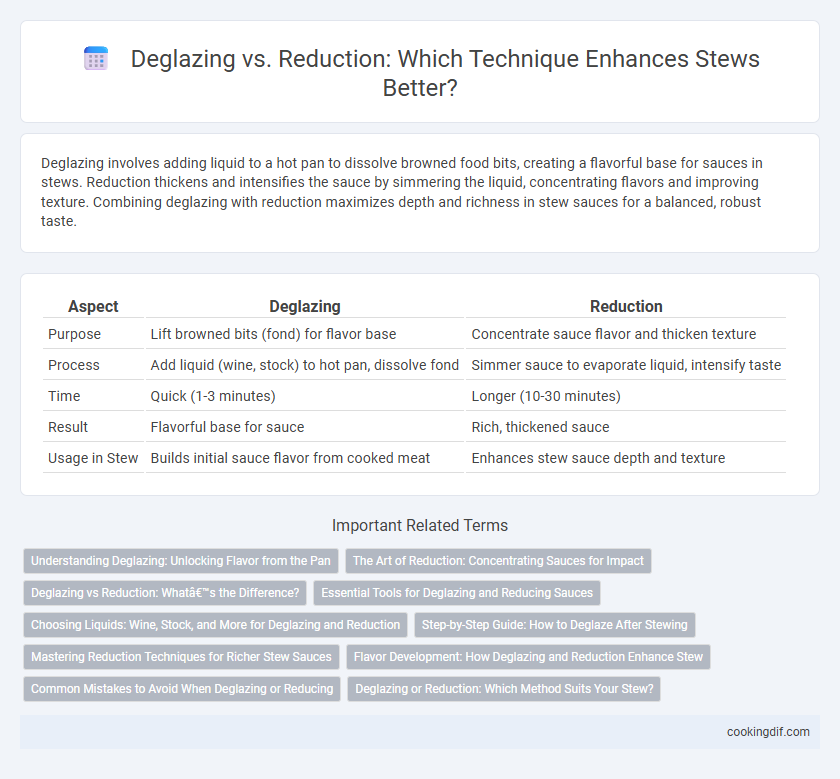Deglazing involves adding liquid to a hot pan to dissolve browned food bits, creating a flavorful base for sauces in stews. Reduction thickens and intensifies the sauce by simmering the liquid, concentrating flavors and improving texture. Combining deglazing with reduction maximizes depth and richness in stew sauces for a balanced, robust taste.
Table of Comparison
| Aspect | Deglazing | Reduction |
|---|---|---|
| Purpose | Lift browned bits (fond) for flavor base | Concentrate sauce flavor and thicken texture |
| Process | Add liquid (wine, stock) to hot pan, dissolve fond | Simmer sauce to evaporate liquid, intensify taste |
| Time | Quick (1-3 minutes) | Longer (10-30 minutes) |
| Result | Flavorful base for sauce | Rich, thickened sauce |
| Usage in Stew | Builds initial sauce flavor from cooked meat | Enhances stew sauce depth and texture |
Understanding Deglazing: Unlocking Flavor from the Pan
Deglazing involves adding liquid such as wine, broth, or vinegar to a hot pan to dissolve caramelized bits called fond, which are packed with rich, concentrated flavors. This technique unlocks intense savory notes that form the foundation of a deeply flavored stew sauce, enhancing its complexity without additional seasoning. Mastering deglazing maximizes the extraction of aromatic compounds and natural sugars from the browned residues, elevating the overall taste profile.
The Art of Reduction: Concentrating Sauces for Impact
Reduction intensifies stew sauces by simmering liquids to evaporate water, concentrating flavors and achieving a thicker, richer consistency that clings to ingredients. This technique enhances the depth and complexity of the sauce, highlighting savory notes and balancing acidity for a more impactful taste experience. Mastery of reduction transforms ordinary stews into gourmet dishes by elevating the sauce's texture and flavor intensity.
Deglazing vs Reduction: What’s the Difference?
Deglazing involves adding liquid like wine or broth to a hot pan to dissolve browned bits, creating a flavorful base for sauces, while reduction refers to simmering liquid to concentrate flavors and thicken texture. Deglazing captures caramelized residues immediately after cooking, providing depth, whereas reduction intensifies the sauce's taste and consistency over time. Both techniques enhance stew sauces differently: deglazing extracts initial savory essences, and reduction refines and amplifies the flavor profile.
Essential Tools for Deglazing and Reducing Sauces
Essential tools for deglazing and reducing sauces include a heavy-bottomed stainless steel pan, which ensures even heat distribution to prevent burning, and a heat-resistant silicone spatula to scrape flavorful browned bits from the pan's surface. A liquid measuring cup with a spout facilitates precise addition of broths, wine, or vinegar crucial for deglazing. High-quality wooden or metal spoons aid in stirring during the reduction process, allowing better control over sauce thickness and concentration of flavors.
Choosing Liquids: Wine, Stock, and More for Deglazing and Reduction
Choosing the right liquids for deglazing and reduction significantly impacts stew sauce enhancement, with wine bringing acidity and depth, while stock adds richness and body. Wine, such as dry red or white, releases flavorful browned bits from the pan, creating a complex base, whereas stock concentrates savory elements during reduction for a robust finish. Incorporating other liquids like vinegar, beer, or fruit juices can introduce unique flavor profiles, complementing the primary ingredients and balancing the stew's overall taste.
Step-by-Step Guide: How to Deglaze After Stewing
After stewing, remove the meat and vegetables to a plate, leaving the browned bits, called fond, in the pan. Pour a small amount of liquid such as wine, broth, or stock into the hot pan to loosen the fond, scraping gently with a wooden spoon to incorporate these flavorful residues into the sauce. Simmer the mixture briefly until it slightly thickens, enhancing the sauce's depth and complexity without reducing the entire volume.
Mastering Reduction Techniques for Richer Stew Sauces
Mastering reduction techniques enhances stew sauces by intensifying flavors and achieving desired thickness through controlled simmering, allowing water and volatile compounds to evaporate. Deglazing with wine, broth, or vinegar dissolves flavorful browned bits from the pan's surface, adding depth and complexity before reduction. Combining deglazing and careful reduction concentrates natural sugars and umami, resulting in rich, velvety sauces perfect for hearty stews.
Flavor Development: How Deglazing and Reduction Enhance Stew
Deglazing captures the browned bits, or fond, at the bottom of the pan, infusing the stew with deep, caramelized flavors by dissolving these concentrated taste compounds into the liquid. Reduction intensifies the stew's flavor by evaporating water content, concentrating the aromas and creating a thicker, richer sauce. Combining deglazing and reduction unlocks complex, layered taste profiles that elevate the overall richness and depth of the stew.
Common Mistakes to Avoid When Deglazing or Reducing
Common mistakes to avoid when deglazing or reducing stew sauces include overheating the pan, which can burn the fond and create bitter flavors, and adding liquids too quickly, preventing proper fond dissolution. Avoid reducing the sauce too aggressively, as this can lead to a sauce that is overly thick or salty, compromising balance and texture. Proper temperature control and gradual liquid incorporation ensure optimal extraction of flavor and a smooth, well-rounded sauce.
Deglazing or Reduction: Which Method Suits Your Stew?
Deglazing enhances stew by dissolving caramelized bits from the pan with liquid, infusing rich, complex flavors quickly. Reduction, on the other hand, intensifies the sauce by simmering it down to concentrate flavors and thicken the consistency. Choosing between deglazing and reduction depends on the desired depth and texture of your stew's sauce.
Deglazing vs reduction for sauce enhancement Infographic

 cookingdif.com
cookingdif.com